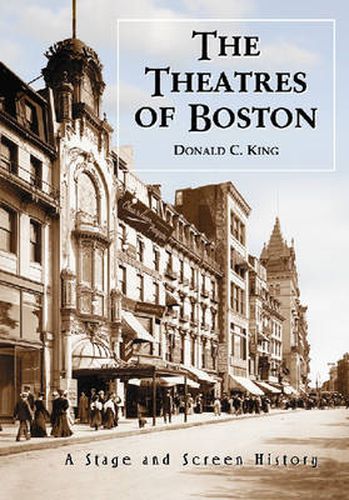Readings Newsletter
Become a Readings Member to make your shopping experience even easier.
Sign in or sign up for free!
You’re not far away from qualifying for FREE standard shipping within Australia
You’ve qualified for FREE standard shipping within Australia
The cart is loading…






This title is printed to order. This book may have been self-published. If so, we cannot guarantee the quality of the content. In the main most books will have gone through the editing process however some may not. We therefore suggest that you be aware of this before ordering this book. If in doubt check either the author or publisher’s details as we are unable to accept any returns unless they are faulty. Please contact us if you have any questions.
The theatre had a difficult time establishing itself in Massachusetts. Colonial authorities in Boston were adamantly opposed to theatrical amusements of any kind. In the mid-eighteenth century, even theatricals performed in the homes of private citizens aroused the indignant ire of puritanically minded authorities. In 1750 the General Court of Massachusetts passed an act prohibiting stage plays or any other theatrical entertainment. In 1762, the New Hampshire House of Representatives refused a theatre troupe admission to the town of Portsmouth on the ground that plays had a ‘peculiar influence on the minds of young people and greatly endangered their morals by giving them a taste for intriguing amusement and pleasure.'The first public dramatic performance in Boston was produced at a coffeehouse on State Street by two English actors and some local volunteers. In 1775 General John Burgoyne, himself an actor and playwright, converted Boston’s Faneuil Hall into a theatre, where he presented, among other pieces,
The Blockade of Boston . After the Revolutionary War, in February 1794, the dramatic history of Boston may be said to have begun with the opening of the Boston Theatre.The history of Boston theatres from the eighteenth century through the present is covered in this well illustrated work. Although the theatre had a somewhat rocky beginning, by 1841 more than 15 theatre houses - including the Boston Theatre, Concert Hall, Merchants Hall, Boylston Hall, the Washington Gardens Amphitheatre, the Tremont Theatre, the Washington Theatre, the American Amphitheatre, the Federal Street Theatre, Mr. Saubert’s Theatre, the Lion Theatre, the National Theatre (which boasted gas lighting), and the Howard Athenaeum - were all established.After these first theatres paved the way and puritanical restraint had been overcome, the public’s enthusiasm for varied entertainment prevailed and theatres proliferated in the city. This book details the long and storied history of Boston theatre construction, alteration, restoration, and, in many cases, destruction. Information is also provided about building architecture, types of performances, ticket prices and other interesting data about each theatre’s history.
$9.00 standard shipping within Australia
FREE standard shipping within Australia for orders over $100.00
Express & International shipping calculated at checkout
This title is printed to order. This book may have been self-published. If so, we cannot guarantee the quality of the content. In the main most books will have gone through the editing process however some may not. We therefore suggest that you be aware of this before ordering this book. If in doubt check either the author or publisher’s details as we are unable to accept any returns unless they are faulty. Please contact us if you have any questions.
The theatre had a difficult time establishing itself in Massachusetts. Colonial authorities in Boston were adamantly opposed to theatrical amusements of any kind. In the mid-eighteenth century, even theatricals performed in the homes of private citizens aroused the indignant ire of puritanically minded authorities. In 1750 the General Court of Massachusetts passed an act prohibiting stage plays or any other theatrical entertainment. In 1762, the New Hampshire House of Representatives refused a theatre troupe admission to the town of Portsmouth on the ground that plays had a ‘peculiar influence on the minds of young people and greatly endangered their morals by giving them a taste for intriguing amusement and pleasure.'The first public dramatic performance in Boston was produced at a coffeehouse on State Street by two English actors and some local volunteers. In 1775 General John Burgoyne, himself an actor and playwright, converted Boston’s Faneuil Hall into a theatre, where he presented, among other pieces,
The Blockade of Boston . After the Revolutionary War, in February 1794, the dramatic history of Boston may be said to have begun with the opening of the Boston Theatre.The history of Boston theatres from the eighteenth century through the present is covered in this well illustrated work. Although the theatre had a somewhat rocky beginning, by 1841 more than 15 theatre houses - including the Boston Theatre, Concert Hall, Merchants Hall, Boylston Hall, the Washington Gardens Amphitheatre, the Tremont Theatre, the Washington Theatre, the American Amphitheatre, the Federal Street Theatre, Mr. Saubert’s Theatre, the Lion Theatre, the National Theatre (which boasted gas lighting), and the Howard Athenaeum - were all established.After these first theatres paved the way and puritanical restraint had been overcome, the public’s enthusiasm for varied entertainment prevailed and theatres proliferated in the city. This book details the long and storied history of Boston theatre construction, alteration, restoration, and, in many cases, destruction. Information is also provided about building architecture, types of performances, ticket prices and other interesting data about each theatre’s history.